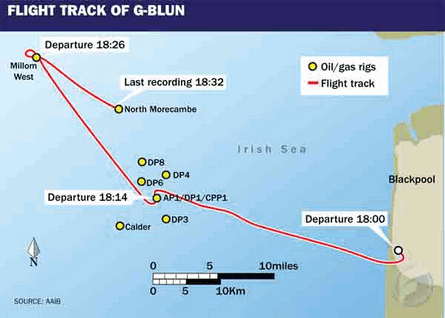Helicopter operators should make use of simulators for their pilot recurrent training and checking, according to one of six recommendations by the UK Air Accidents Investigation Branch in its final report on the 27 December 2006 fatal crash of a CHC Scotia Eurocopter SA365N Dauphin 2 helicopter.
The UK Civil Aviation Authority says it has accepted this recommendation.
The two pilots and five passengers were all killed instantly when the helicopter (G-BLUN), adopted an extreme attitude and hit the sea at high speed during an attempted night visual approach in poor visibility to the North Morecambe gas platform off England's north-west coast.
No technical failures occurred, says the report, which concludes that pilot mishandling during the approach resulted from the crew's difficulty in obtaining sufficient visual cues to monitor a steady descent profile toward the platform, despite the fact that the meteorological situation was within limits.
 |
|---|
The crew had just successfully flown two sectors on to other Morecambe Bay rigs since its departure from Blackpool (see diagram). Soon after the pilots stated they had visual contact with the North Morecambe platform they both commented it was difficult judging distance and approach angle.
The co-pilot, who was the pilot flying, then became disorientated and asked the captain for assistance, says the AAIB. But because the request was not voiced in standard language, it was 4s before the captain took control, and by that time the aircraft was descending through 290ft (90m) above sea level, was banked right 38º, the nose-down pitch was 38º, the speed was increasing toward 90kt (165km/h) and the rate of descent was 2,000ft/min (10.16m/s).
The captain took control, rolled the aircraft through wings level to 7° right, and reduced the pitch to 13° nose down, but the aircraft continued to descend to impact with the sea as the captain also struggled with disorientation. The automatic voice alert device was providing height calls as prescribed.
The AAIB observes, as a contributory factor, that a Dauphin simulator was available for crew training, but CHC Scotia did not use it, and the CAA has since accepted the AAIB's recommendation that "the recurrent training and checking of JAR Ops Part 3 operators should be carried out in an approved synthetic training device".
Other recommendations include that CHC Scotia should review its standard operating procedures for approaches, particularly with respect to the assistance the non-flying pilot should provide to the pilot flying during approaches in poor visibility or at night, and that the European Aviation Safety Agency should research "without delay" systems that would provide instrument approaches to oil and gas platforms for use in poor visibility conditions.
Learmount's blog on the subject: Helicopters need help...
Source: Flight International























